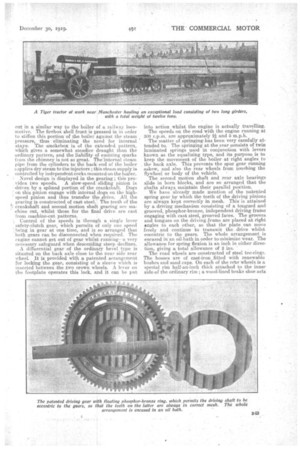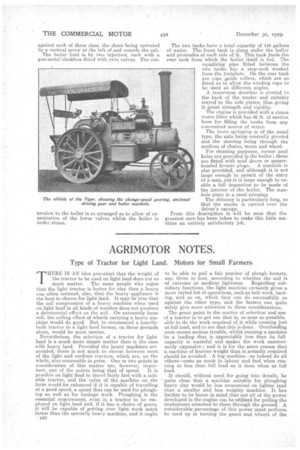THE TIGER STEAM TRACTOR.
Page 20

Page 21

Page 22

If you've noticed an error in this article please click here to report it so we can fix it.
A Fowler Patent Compound Spring-mounted Road or Agricultural Tractor of Ample Power, but Light Weight.
WHEN THE NEED develops for any particular. type of steam-propelled agricultural or road vehicle, or a combination of the two, -John Fowler and Co. (Leeds), Ltd., are always well to the fare in supplying 'that' need. At present .there appears to be a considerable call for a, light, cheap, but at the same time reliable combined road and agricultural tractor weighing five tons or tinder. To meet this 'demand the, company have produced the Tiger steam tractor, the total weight of which is under five tons. It can be fitted with either steel or rubbertyred wheels suitable for agricultural work or for haulage on roads. The design is new throughout and embodies the latest improvements made in light road locomotives. The boiler design, oonStru.ction and testing, are wider the observation, and have met with the approval of, the Manchester Steam Users' Association.
The new tractor is provided with couplings at each end, so that it can pull a plough in either direction without turning. It also incorporates a patented spring gear by which the driving gears are always in accurate mesh, and do not slide in and out of correct mesh, as is the case in many other vehicles of this description. To have accurate and constant pitch circles for the gearing is a better engineering proposition than to have these circles altering at every flexion of -the spring. Apart from this point in the springing, there are other novel features which we will describe in detail fOrther on in the text.
The tractor has an engine of the compound type, in which, for starting and hill-climbing purpose, both avlinders can use H.P. steam, exhausting independently. A useful fitment is a winding-forward drum, which is fitted on the rear axle close to the offside rear wheel ; it is provided with 50 to 75 yards of steel rope B-16 for winding the loads up gradients and across soft. ground. It can also be used for winding the engine itself out of awkward places.
The motion work and gearing are particularly well protected by side cover plates and steelcasings: These casings -obviate any risk of the driver being caught up by the gearing or other moving parts. ! The designers of the engine have made a particular point of reducing weight so far as possible with out sacrificing strength, and they do this in many cases by 'substituting pressings or forgings for castings.
The boiler works at a• pressure of 200 lb. per sq. in., which is the highest pressure for which boilers are made by the company ; the usual pressure employed in their other boilers is 180 lb. per sq. in.
We will continue the description by .giving a more detailed and technical account of the various, poi/16 of interest in this tractor. , The_cylinders have ebore and stroke of 4/ ins. by 9 ins. and 7i ins. by 9 ins. respectively. They are formed of one casting,which is thoroughly steamjacketed. The lubrication of the slide valves and pistons is effected by a mechanical lubricator operated by a ratchet driven from the valve spindle. The slide valves are of the ordinary D Pattern, and a-re of gun-metal. The ports are designed to give quick admission and emission of steam.
The pistons are wrought steel stampings secured to the piston rods by nuts and pins. The ends of these , rods are tapered and the pistons ground in. The . valve gear is the well-known Stephenson link motion.
' The link motionis constructed of best Yorkshire iron, the wearing surfaces being thoroughly case hardened and ground. The valve eccentrics are cast en bloc and held to the crankshaft. by a single large key. To ensure ample lubrication large oil chambers are provided for -the eccentric straps. Mild steel is used for the connecting rods. The crankpin ends are provided with steel straps secured by tat•o• bolts ; in these are held gun-metal bushes adjustable by means of gibs and cotters. Lubricators are provided on these straps.
The cross-heads are made of wrought steel and work on a single slide bar of the locomotive pattern. Re newable gun-metal slippers are provided to allow for wear at this 'point. All the shafts are forged from steel ingots whilst the second motion and -rear axle . bearings arid •horn blocks are of cast steel •provided with gun-metal bushes. The crankshaft bearings are • bolted direct to the boiler shell. They are strongly stayed and are provided with four-piece gun-metal liners. The crankshaft is of the double-webbed loco. type, carefully balanced to ensure steady running. A flywheel of the disc pattern is utilized, and this is turned on both the face and edges so as 'to make it suitable for belt driving.
The operation of converting the compound engine into double cylinder, is performed by one leer. This moves a spindle controlling two valves which separate the cylinders ; another valve, which lets H.P. ,steam into the L.P. cylinder, is also opened: The valve is SC? designed that the L.P. Winder does not receive the full pressure of steam. The steam pressure is so adjusted that each eylinder gives approximately the same power, otherwise they would be out of balance and would cause undue vibration.
The engine is mounted on the top of a boiler of the simplified belpaire type. It is fitted with an mproved type firebox, "which gives the maximum amount of. heating Surface, and it is stayed throughs out in a similar way to the boiler of a railway locomotive. • The firebox shell front is pressed in in order to stiffen this portion of the boiler against the steam pressure, thus eliminating the need for internal stays.. The smokebox is of the extended pattern, which gives a somewhat steadier draught than the ordinary pattern; and the liability of emitting sparks from the chimney is not so great. The'interrial steam pipe from the cylinders to the back end of the boiler supplies dry steam to the injectors ; this steam supply is
_ controlled by independent cocks mounted on the boiler.
Novel design is displayed in the gearing ; this provides two speeds. A slow-speed sliding pinion is • driven by a splined portion of the crankshaft. Dogs on this pinion engage with internal dogs on the high' speed pinion and thus transfer the ..drive. All the . gearing is constructed of cast steel.. The teeth of the crankshaft and second motion shaft gearing are machine out, whilst those for the final drive are cast from machine-cut patterns. .
Control of the speed§ is through a single lever safety-clutch gear, which permits of only one speed ;being in gear at one time, and is so arranged that both gears can be disconnected when required. The engine cannot get out of gear whilst-running--a very necessary safeguard when descending steel) declines.
A differential gearof the ordinary bevel type is situated on the back axle close to the near side rear wheel. It is provided with a, patented arrangement for locking the gear, consisting of a sleeve which is inserted between the. two crown wheels. A lever on the footplate operates this lock, and it can be put
into action whilst the engine is actually travelling. The speeds on the road with the engine running at 300 r.p.m. are approximately 2i and 5 m.p.h. The matter of springing has been very carefully attended to. The springing at the tear consists of twin laminated springs used in conjunction with levers known as the equalizing type, and its purpose is to keep the movement of the boiler at right angles to the back axle. This prevents the spur gear running askew, and also the rear wheels from touching the flywheel or body of the vehicle. The second motion shaft and rear axle bearings slide in horn blocks, and are so arranged that the shafts always maintain their parallel position. We have already made mention of the patented spring gear by which the teeth of the driving pinions are always kept correctly in mesh. This is attained by a driving mechanism consisting of a tongued and grooved, phosphor-bronze, independent driving frame engaging with cast steel, grooved faces. The grooves and tongues on the driving .frame are placed at right angles to each other, so that the plate can move freely and continue to transmit the drive whilst eccentric to the gears. The whole arrangement is encased in an oil-bath in order to. minimize wear. The allowance for spring flexion is an inch in either direction, giving a total allowance of 2 ins. " The road wheels are constructed of steel tee-rings. The bosses are of east-iron ,fitted with renewable bushes and sand caps. On each of the rear wheels is a special rim half-an-inch thick attached to the inner side of the ordinary rim ; a wood-lined brake shoe acts against each of these rims, the shoes being operated by a vertical screw at the left of and outside the cab. The boiler feed is by two injectors, each with a gun-metal elankbox fitted with twin valves. The con neetion to the boiler is so arranged as to allow of examination. of the lower valves whilst the boiler is under steam, The two tanks have a total capacity of 145 gallons of water. The front tank is slung under the boiler and protrudes at each side of it. This 'tank feeds the rear tank from which the boiler itself is fed. The equalizing pipe fitted between the two tanks hay a stop-cock worked from the footp ate. On the rear tank are rope guide rollers, which are so fitted as to allow the winding rope to be nsed at different angles.
A transverse drawbar is riveted to the back of the tender and suitably stayed to the side plates, thus giving it .great strength and rigidity.
The engine is provided with a steam water lifter which has 26 ft. of suction hose for filling the tanks from any convenient' source of water.
The front springing is of the usual type, the axle being centrally pivoted and the steering being through the medium of chains, worm and wheel.
For cleaning purposes, corner mud holes are provided 41 the boiler ; these are fitted with mud doors or squareheaded bronze plugs. A manhole is also provided, and although it is net large enough to permit of the entry of a man, yet it is large enough to enable a full inspection to be made of the interior of the boiler. The manhole plate is a steel pressing.
The chimney is particularly long, so that the smoke is carried over the driver's canopy.
From this description it IN ill be seen that the greatest care has been taken to make thin little machine an. entirely satisfactory job.


























